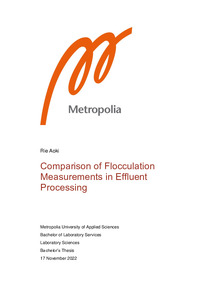Comparison of Flocculation Measurements in Effluent Processing
Aoki, Rie (2022)
Aoki, Rie
2022
All rights reserved. This publication is copyrighted. You may download, display and print it for Your own personal use. Commercial use is prohibited.
Julkaisun pysyvä osoite on
https://urn.fi/URN:NBN:fi:amk-2022112924907
https://urn.fi/URN:NBN:fi:amk-2022112924907
Tiivistelmä
This thesis work was carried out in the water treatment team at the Kemira Espoo R&D Center. The aim of this work was to find some trends and coefficients from jar test parameters that were tested under different conditions with Suomenoja effluents using the device PDA3000.
Eight different sets of jar tests were done. Different coagulant amounts were used for chemical tests using two different coagulant chemicals. For pH adjustment tests, pH adjustment chemicals were added in addition to the coagulants. Different flocculator rapid mixing speeds were compared in the rapid mixing rate test. Different flocculator time settings were compared in the rapid mixing time, slow mixing time and sedimentation time tests. Only one coagulant chemical “chemical-1” was used for the rapid mixing rate, rapid mixing time, slow mixing time and sedimentation time tests. All test samples were measured for pH, zeta potential, turbidity, UV254 absorbance, COD, TOC, DOC and iron or aluminum as well.
Based on the maximum flocculation index, the best results using chemical-1 were 300 µmol dose, 200 rpm for rapid mixing rate, 20 s for rapid mixing time, 30 min for slow mixing time and 20 min for sedimentation time. 150 µmol dose had the best flocculation index in the pH adjustment test. However, considering the other parameters, the 400 µmol dose was better than the 150 µmol dose. 400 µmol dose was best for the chemical-2 test and 300 µmol dose was best for the pH adjustment test using chemical-2. Compared to the other doses, however, the maximum flocculation index differences were not significant.
Eight different sets of jar tests were done. Different coagulant amounts were used for chemical tests using two different coagulant chemicals. For pH adjustment tests, pH adjustment chemicals were added in addition to the coagulants. Different flocculator rapid mixing speeds were compared in the rapid mixing rate test. Different flocculator time settings were compared in the rapid mixing time, slow mixing time and sedimentation time tests. Only one coagulant chemical “chemical-1” was used for the rapid mixing rate, rapid mixing time, slow mixing time and sedimentation time tests. All test samples were measured for pH, zeta potential, turbidity, UV254 absorbance, COD, TOC, DOC and iron or aluminum as well.
Based on the maximum flocculation index, the best results using chemical-1 were 300 µmol dose, 200 rpm for rapid mixing rate, 20 s for rapid mixing time, 30 min for slow mixing time and 20 min for sedimentation time. 150 µmol dose had the best flocculation index in the pH adjustment test. However, considering the other parameters, the 400 µmol dose was better than the 150 µmol dose. 400 µmol dose was best for the chemical-2 test and 300 µmol dose was best for the pH adjustment test using chemical-2. Compared to the other doses, however, the maximum flocculation index differences were not significant.
